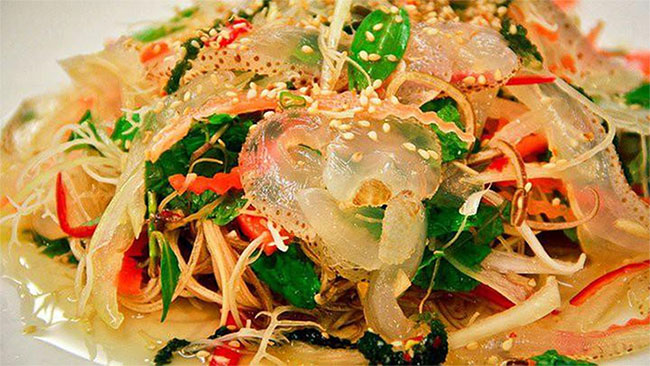Note when eating jellyfish to avoid being poisoned
However, the Department of Health Food Safety Bureau said there are many types of jellyfish. Some types of jellyfish contain very strong toxins, need to process jellyfish properly before eating, should not use fresh unprocessed sea jellyfish because toxins in fresh jellyfish can be life-threatening to eaters. , including prepared jellyfish.
Things to know when eating jellyfish
- Marine jellyfish poisoning is life-threatening
- Lightweight
- Dark level
- Can be granted or subacute
- Who should not eat jellyfish?
- How to process sea jellyfish into delicious, safe food
According to experts of Nha Trang Oceanography Institute, if you go to the beach, when seeing the jellyfish though very eye-catching, you should stay away from them to avoid being stung from jellyfish. Jellyfish are invertebrates, living in the sea or in salt water. Living jellyfish contains a lot of toxins and when touched, humans will be allergic.
Marine jellyfish toxins are usually concentrated in tentacles, which use acupuncture cells called nematocysts . These cells are very small and toxic. Some jellyfish have millions of nematocysts in their tentacles, used when jellyfish catch prey and protect themselves.

Jellyfish is a cool, nutritious dish used to prepare some dishes that are suitable for summer days.
Marine jellyfish poisoning is life-threatening
Lightweight
When jellyfish bites, these toxins will penetrate the human skin into the body. If mild, the victim only skin reaction, local rash, redness and itching, the whole body will feel uncomfortable. However, do not worry too much in this case.
Dark level
The incident occurred immediately after the jellyfish toxin entered the victim's blood. Victims hangover, headache, chest tightness, cyanosis, sweating, shortness of breath, nausea, vomiting, abdominal pain and diarrhea many times, rapid pulse, small, low blood pressure.
The victim enters a state of drowsiness, sometimes convulsions, may coma need to be taken immediately to the hospital to prevent anaphylaxis.
Can be granted or subacute
After about 15 minutes of encountering jellyfish, the victim has itchy hands, feet, localized erythema, generalized urticaria, quineke edema in eyes, lips, face, larynx should suffocate, rapid pulse, weak.
The heart beats steadily, the blood pressure drops, a dry cough, wheezing is difficult. Laryngeal edema causes breathing difficulties. Victims nausea, abdominal pain, diarrhea, watery eyes, runny nose, sweating. This is an anaphylactic manifestation that needs to be taken immediately to an anti-shock hospital.

Who should not eat jellyfish?
According to experts of the Food Safety Department of the Ministry of Health, jellyfish is a nutritious and cool dish and is used to prepare some dishes suitable for summer days such as: salad, jellyfish salad, hotpot, soup, and jellyfish noodles. . However, jellyfish should not be eaten by children under 8 years of age, including processed jellyfish. Because this is a very sensitive age, the resistance is still poor, if eating jellyfish will be very susceptible to allergies or poisoning. Therefore, parents should pay attention to this when taking families on vacation on the beach or during regular meals.
Besides, there are some groups of people who should not use jellyfish, including those that have been carefully cooked and cooked, including:
- People who are allergic to seafood;
- The new one got up;
- People with physical weakness;
- People who have had food poisoning in the past.

To ensure the prevention of food poisoning, the Department of Food Safety recommends that people do not use fresh unprocessed sea jellyfish as food or raw salad.
How to process sea jellyfish into delicious, safe food
To ensure the prevention of food poisoning, the Department of Food Safety recommends that people do not use fresh unprocessed sea jellyfish as food or raw salad.
Especially do not use jellyfish (including processed jellyfish) as food for children. Use only properly processed jellyfish.
Processing of fresh jellyfish must be soaked through 3 times in salt water and alum, when jellyfish meat turns to light red or light yellow to be used for processing as food. Jellyfish should not be eaten during their breeding season, as this time the jellyfish accumulates a lot of toxins in the body. Be careful not to give jellyfish to children to prevent diarrhea.
In addition, when you eat dried pressed jellyfish, which is often sold in stores or supermarkets, it is better to wash it thoroughly before processing. This approach can help limit the chemicals used in the preparation of jellyfish, which is healthier.
- Strange and interesting things make visitors surprised about Africa
- AIM-9 Sidewinder: The most dangerous heat-resistant rocket in the world today
- 9 things you probably didn't know about Jerusalem
- Note when eating snails to avoid processions into the body
- Things to avoid when eating fruitful things you should know
- 65 interesting things about jellyfish (1)
- Aggressive jellyfish eat offspring to survive
- It is taboo when eating vegetables but many people still do not know
- Jellyfish species can 'knock down' American carriers
- 65 interesting things about jellyfish (2)
- Beautiful sparkling jellyfish kingdom
- Do you know how jellyfish burn us?
- Beauty of jellyfish in the dark
- Startled with the danger of jellyfish invading the oceans
- Jellyfish cannot 'invade' the planet
 Chinese doctors have created medical masks that cover only the nose for convenience of eating and drinking
Chinese doctors have created medical masks that cover only the nose for convenience of eating and drinking Scientists have found a way to help you regrow new teeth after only 2 months
Scientists have found a way to help you regrow new teeth after only 2 months Do non-stick pans cause cancer? What alternatives are there?
Do non-stick pans cause cancer? What alternatives are there? Blisters around the body: Causes, symptoms and treatment
Blisters around the body: Causes, symptoms and treatment